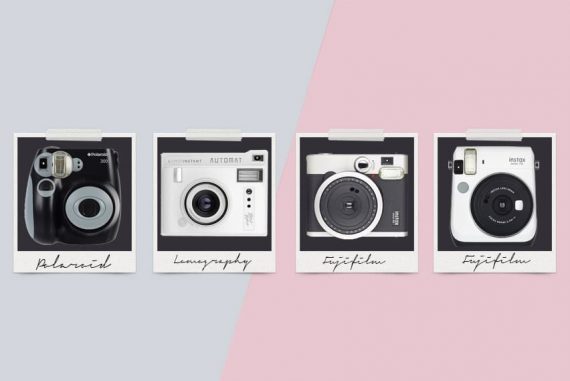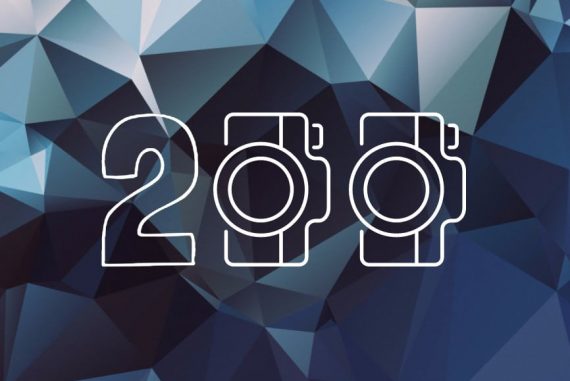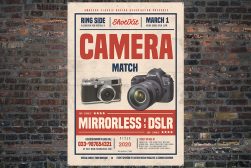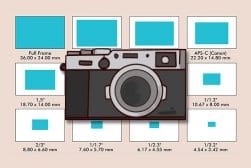
Guide to Different Types of Cameras
From compact point and shoot to full frame mirrorless and medium format film cameras, this is a pocket guide to the most common camera types in 2024.
Learn | Photography Guides | By Andy Day
There is a bewildering array of different types of camera available to photographers of all levels here in 2024.
From a beginner point and shoot or DSLR camera all the way up to medium format, choosing the right camera body can be confusing.
This guide will explain the best types of cameras for each photography situation to help you make the right choice.
Let’s dive right in.
12 Popular Camera Types for Photography in 2024
From the smallest and cheapest to the heaviest and most expensive, cameras come in a wide range of sizes and prices.
Some are ideal for travel and casual use, while others are designed specifically with commercial projects in mind.
Some camera manufacturers produce a camera body in each of the categories below, while others focus on offering one specific type.
In this article, we’ll have a brief look at the pros and cons of each.
1. DSLR Cameras

Nikon DSLR Cameras of Citlalli Rico.
DSLR — Digital Single Lens Reflex — cameras are popular with amateurs and professionals alike, and even entry-level bodies can be used to create high-quality results. (They’re the digital version of old-fashioned SLR cameras, which use film.)
There’s a huge array of interchangeable lenses and other accessories available for DSLR cameras making them incredibly versatile tools. DSLRs can usually be found for less than $500, making them perfect if you’ve just started learning photography.
Also, you have complete control over a DSLR, as well as being able to use semi- and fully-automatic modes that make photography even easier, especially if you’re a beginner.
The ability to change lenses means that you can buy everything from a telephoto zoom lens for shooting sports and wildlife, to a portrait prime lens, useful for creating images with a narrow depth of field (DOF) or capturing photos in low light.
The optical viewfinder found on a DSLR camera means that you can be precise with your focusing and there’s no lag between what you see and what you capture when you push the button. (You’re basically looking through a transparent piece of plastic or glass.)
DSLR sensors come in two sizes: full-frame (36mm x 24mm) gives the best image quality while the smaller APS-C (a.k.a. crop sensor) allows more compact bodies and lenses, as well as being more affordable.
The larger sensors in these types of cameras are a significant advantage over those found in the average compact camera or smartphone, giving better picture quality, better dynamic range, less noise, and greater potential to capture a sharp subject against a blurred background, creating a cinematic feel.
DSLRs also offer better ergonomics than compact digital cameras and most mirrorless cameras and usually offer a more robust camera body too.
DSLRs are used to photograph pretty much everything, from kids’ soccer games to warzones.
2. Mirrorless Cameras

Fujifilm mirrorless cameras of Javier Abad.
The next type of camera on our list is one of the most popular formats here in 2024. Ever since cameras were invented, photographers have been wanting something better… and mirrorless seems to be the answer.
Mirrorless cameras are the successors of DSLRs. By removing the mirror and replacing the optical viewfinder with an electronic viewfinder, manufacturers introduced a host of features and advantages.
In fact, the technology has now matured enough in recent years that DSLRs are starting to feel like an outdated camera type.
How Much Do You REALLY Know About Photography?! 🤔
Test your photography knowledge with this quick quiz!
See how much you really know about photography...

Mirrorless cameras are the choice of many professional and amateur photographers. Electronic viewfinders (EVF) are now almost indistinguishable from their optical counterparts (OVF), and they bring other advantages, such as live histograms, zebras, and focus magnification – learn more about camera viewfinders here.
The EVF is unique to this type of camera, allowing the photographer to preview exposure settings in real-time, making photography easier and more intuitive.
Without the mirror system found in DSLRs, these cameras are often slightly smaller, too. Other advantages include silent shooting, autofocus that can find and follow a person’s eye or track objects, and the ability to shoot a burst of images incredibly quickly.
Depending on the model, they also offer customisable camera settings, multiple focus modes, high-resolution sensors, wi-fi image transfer, HD recording, HDMI video output, accelerated shutter speed modes (via the electronic shutter), and more.
The range of lenses available isn’t yet as extensive — especially among manufacturers such as Nikon and Canon who have only recently introduced mirrorless camera models — but the lack of lens options isn’t much of a disadvantage given that you can easily use an adapter to convert lenses designed for DSLR cameras.
As for sensor sizes, mirrorless cameras are available with full-frame, APS-C, or Micro Four Thirds sensors.
3. Compact Cameras / Point & Shoot Cameras

Pocketable size is the main advantage of compact cameras.
Compact cameras — a.k.a. point-and-shoot cameras — are designed to be small and easy to use, allowing a photographer to grab a great image in a wide range of situations. Smaller options don’t have a viewfinder — just an LCD screen on the back.
Most compact cameras offer a lot of automation, but more advanced bodies will give users a degree of control over things like ISO and shutter speed. Compact cameras are convenient, but only some more advanced (expensive) options will allow you to tweak settings to be more creative with your photos.
The physical size of the sensor on an average compact camera is typically much smaller (1 inch or less) than that found in a DSLR or mirrorless camera… although if you’re prepared to pay a lot more, you can find a compact camera with a Micro Four Thirds, APS-C or even full-frame sensor.
Most compacts are pocketable, fairly durable, not too expensive, and have relatively good battery life. Compared to a DSLR or a mirrorless camera, however, you can’t change lenses, images can be noisy, autofocus often won’t be as fast, dynamic range isn’t great, and the image resolution tends not to be as high.
Popular compacts tend to specialise in one area, sometimes offering an excellent optical zoom range (as opposed to digital zoom), or a rugged build that protects against being dropped, extreme temperatures, and rain and snow.
There’s a huge selection of compact camera types available in 2024, and it’s not uncommon for photographers to own both a compact and a larger mirrorless or DSLR camera, to make the most of both worlds.
4. Bridge Cameras
Bridge cameras sit between compact cameras and DSLR/mirrorless cameras. They give the level of control and ergonomics you’d find on a DSLR, but without the option to change the lens. Typically, autofocus speed tends to be slower too.
Because there’s no mirror, the viewfinder is electronic, so you get advantages such as silent shooting, focus magnification, and a live histogram to help you check your exposure.
Bridge cameras usually have the same small sensors that you’d find in a compact camera. The image quality won’t be good as a DSLR or mirrorless camera, but bridge cameras take advantage of the fact that these smaller sensors make it easier to build lenses that can offer a huge amount of zoom – far more than on a DSLR or mirrorless camera and for a fraction of the price.
You’ll find most of the basic and advanced features found on other types of digital cameras, but usually, there’s a compromise in speed or image quality, typically on cheaper models.
Bridge cameras are great for simplifying the photography experience — you get most of the features of other cameras on the market, without the complications and expense of interchangeable lenses.
If you like the simplicity of point and shoot compact cameras, but need something with better battery life and ergonomics, these types of cameras could be the perfect solution.
5. Instant Cameras

Instant cameras might feel a bit out of place in our digitally perfect world, but this is exactly why they have so much charm.
The analogue imperfection is a throwback to photography’s rich history. You get to watch your image slowly appear in front of your eyes, and you end up with a physical print that you can hold in your hands.
Unlike a digital camera, you won’t have to deal with photo editing software, making the photography experience far simpler, and arguably much more enjoyable too.
Instant cameras tend to be fully automated, making them incredibly easy to use despite their retro feel. The filmstock often has a vintage vibe, similar to filters you see on social media.
Also, using an instant camera might make you more considered in your image-making, given that each shot that you take will cost money. You can’t simply blast away as you can with a digital camera.
With instant, there aren’t many different types of cameras to choose from, with Polaroid and Instax being the most popular camera brands. The average instant camera is usually cheap, but be aware that the price of the film can quickly add up.
These types of cameras are commonly seen at events and weddings, where guests aren’t required to fiddle with settings – they can simply take a photo and have the print in their hands a moment later.
6. Film Cameras
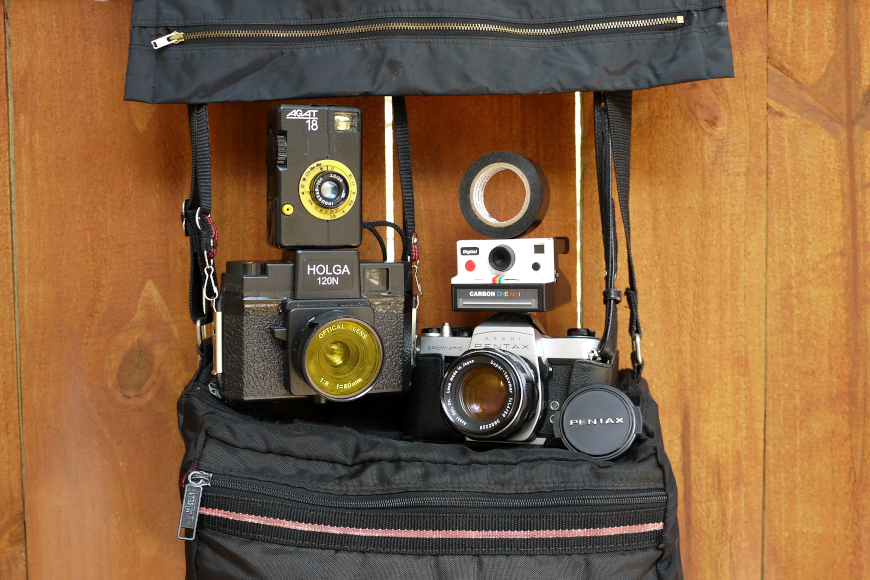
Pentax & Holga film cameras of John Catbagan.
Shooting on film is different to digital on many levels. Film cameras make you more considered and deliberate in your image-making, and the physicality of loading the camera and knowing that your photographs are occurring as a chemical process is very satisfying.
Photographing with a film camera makes you feel as though you are creating something more permanent and meaningful, compared to pixels from a digital camera.
The full-frame (35mm) sensor means that you can achieve a glorious shallow depth of field (for creating a ‘bokeh’ background), and there’s a huge amount of second-hand gear available, often at very low prices.
Film compares well to the quality and high resolution of today’s digital cameras, and the superior dynamic range and distinctive look and feel given by film cameras mean that many photographers still prefer it.
Film is an ongoing cost, but there’s a wide choice of film stock available. Also, the process of scanning photos and negatives has never been easier.
There’s no instant feedback on a film camera to tell you if you’ve exposed or focused correctly, and many older camera types might not even meter the light for you. Not only will you need to dial in the settings yourself, but you’ll also have to calculate them for yourself first!
In addition to 35mm, you can also still find medium and large format film cameras for sale in second-hand camera shops. Medium and large format camera types offer greater depth of field than 35mm but also tend to be more cumbersome to use, due to their size.
If you’re looking to rekindle your passion for photography, or are disillusioned with the instant-gratification of digital camera types, the answer might be in an old film camera.
7. Action Cameras
Action cameras are tiny devices that go anywhere and attach to anything. These types of cameras are an extreme sports enthusiast’s dream, and make photography possible from places previously unimaginable.
The amount of image-stabilisation on recent models is remarkable – far more advanced than even the most expensive mirrorless or DSLR cameras. Many are waterproof, and those that aren’t can be put inside a watertight housing.
The angle of view is very wide, and there’s no need to focus since everything in your frame will be sharp by default. Exposure is automated, and colours are bright and saturated by default, although some models offer RAW shooting modes.
These types of cameras don’t have a viewfinder, and some don’t even have a screen. However, most connect to smartphones allowing you to set up your shot, take photos, start and stop recording, and then download and edit the footage and images ready to share.
As for the cons, action or adventure cameras are best suited to video rather than stills photography, despite offering both functions. Lenses are fixed, and battery life is usually short.
However, if you need an affordable waterproof camera that can be mounted everywhere from your helmet to your motorbike, an action camera such as the GoPro or one of its alternatives is your best bet for truly immersive first-person perspective photography.
8. 360 Degree Cameras
360-degree cameras are tiny devices similar to action cameras. They have two incredibly wide-angle lenses facing in opposite directions, and footage and photos are stitched together inside the device to give a complete field of view, allowing you to choose your angle during the editing process.
Like action cameras, they connect to your phone so that you can frame shots and download and edit footage. They usually don’t have screens to preview your image.
These types of camera are quite specialist in their use and offer limited versatility. Still, they’re great for holidays and grabbing exciting moments, and are ideal for capturing hyper lapses or anything that requires a first-person perspective.
Certain models also offer unique features, such as the ability to capture ‘photospheres’ and ‘no drone, no problem’ shots with ‘invisible’ selfie sticks.
9. Underwater Cameras / Waterproof Cameras
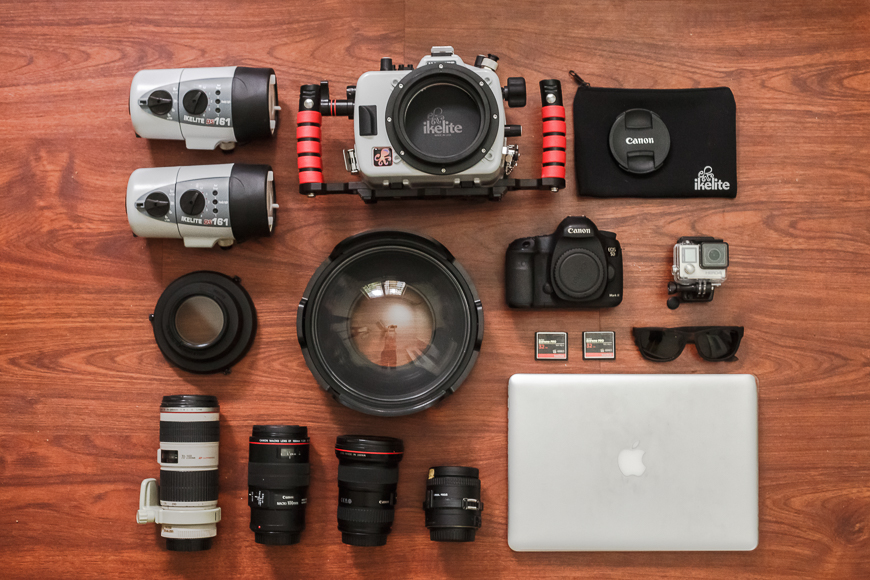
Underwater cameras and housing used by Grant Thomas.
Waterproof cameras come in a variety of shapes and sizes, and vary massively in price, from cheap and cheerful fixed lens cameras to give to your kids to take into the sea with them on holiday, to more serious interchangeable lens cameras designed to be taken on underwater adventures.
Waterproof disposable film cameras can be a lot of fun on holiday, providing an affordable means of capturing moments when you need to leave your smartphone somewhere safe and dry.
For more serious underwater photography, you might want to consider a waterproof point and shoot camera. These are slightly chunkier than regular compact cameras because of the additional sealing.
Most different types of cameras meant for underwater use with or without cases can be taken down to maximum depths of 15 to 30 metres.
There are also underwater cameras designed specifically for scuba divers to take with them to capture sea creatures and shipwrecks, some of which come complete with a lighting rig.
Most action cameras are now waterproof down to a depth of around 10 metres, and any that aren’t can be put inside a watertight housing.
10. Medium Format Cameras
Medium format camera types — whether film or digital — refer to the sensor size, and provide the highest quality of image you can produce from all of the options on our list.
The average medium format camera has dropped dramatically in price in the last couple of years, and the cheapest models are now similar in cost to the most expensive mirrorless and DSLR models.
High-end models can cost tens of thousands of dollars, and medium format camera lenses can also be costly.
Shooting is often a slower process with poorer autofocus performance and low burst speeds, but image quality and resolution are astounding, making medium format cameras a popular choice for professional photographers. Other pros include superior dynamic range and more accurate colour reproduction.
For professional photographers shooting photos for a billboard campaign or magazine cover, medium format cameras are often the ideal choice.
11. SmartPhone Cameras

Well-designed iPhone camera accessories can elevate the photo experience.
Smartphone cameras have put a huge dent in sales of other types of digital cameras over the last decade, and the technology keeps getting better. Today, almost everyone has a powerful digital camera in their pocket.
As well as front-facing cameras, smartphones now pack multiple lenses. Thanks to AI, these lenses can emulate the blurry background that was previously only achievable with a much larger camera, and features like face and even eye autofocus and subject tracking are now standard on new models.
Smartphones also offer night mode that intelligently blends multiple exposures on the fly to make poorly lit scenes much brighter.
The tiny sensors inside smartphones mean limited dynamic range and noisy images when the light drops, but this is easily balanced out by the convenience of having such a capable device close to hand.
Multiple camera apps offer the ability to adjust manual settings as well as adjust image size and format, and the ability to edit, share and backup the photo immediately after taking it is a huge advantage. Many pros use cloud-based editing software such as Adobe Lightroom to do exactly this.
iPhone photography is the fastest growing form of photography in the world, with the latest devices able to capture photos that rival dedicated cameras.
However, taking photos on your phone isn’t a particularly engaging experience, and cons such as limited battery life, lack of a viewfinder, limited RAW capabilities and poor ergonomics mean that the different types of cameras in this guide are all still a popular choice.
12. Rangefinder Cameras
Popular back in the 1950s due to their size, robustness and affordability, these cameras use a dual-image range-finding focusing mechanism to focus.
Essentially, you twist a ring on the lens to align two super-imposed images – when they align, your photo will be in focus.
Whereas with an SLR you’re looking through the lens, with a rangefinder, you’re looking through a ‘window’ situated at the top of the camera. Some photographers love this experience, but it does take some time to get used to.
Most rangerfinders are available second-hand, with only a few brands still producing them to purchase new – Leica is one of them.
Types of Camera FAQs
Which type of camera is best for photography?
It really depends. If your definition of “best” is highest image quality, then medium format cameras win the title. But often the best camera is the one you have with you, in which case even a compact or smartphone camera can be the best. In terms of balance between size, image quality and budget, mirrorless digital cameras are the winners.
How many types of cameras do we have?
That comes down to how you classify them, but in our guide we’ve singled out 11 different camera types including DSLR, mirrorless, medium-format, instant, film, action, and more.
What are the different types of DSLR cameras?
DSLRs come in two main types: full-frame and crop sensor. The difference between the two is the sensor size – a crop sensor crops the edges of your photo for a tighter field of view. Full-frame sensors offer some advantages over their cropped counterparts.
Final Words
The different types of cameras available in 2024 can make the decision a bit confusing, but thankfully, there’s something to fit every budget and every type of photography.
If you’re using a camera type that we’ve missed here, be sure to post it in the comments below.
I hope you found the information in this article helpful, and as always, feel free to ask any questions.

Check out these 8 essential tools to help you succeed as a professional photographer.
Includes limited-time discounts.





